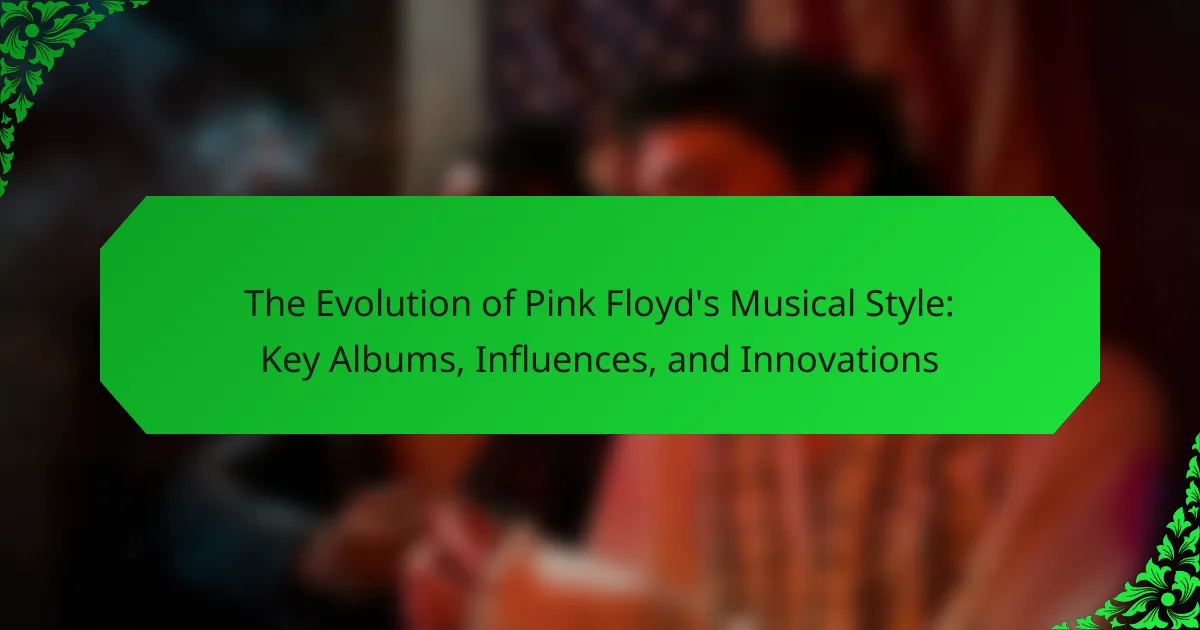Pink Floyd is a British rock band known for their significant evolution in musical style from the 1960s to the 1980s. The article explores their journey from experimental psychedelic music, exemplified by their debut album “The Piper at the Gates of Dawn,” to the complex, concept-driven rock of “The Dark Side of the Moon” and “The Wall.” It highlights key albums that reflect their thematic explorations of mental health, alienation, and societal issues, as well as their innovations in music production and live performances. The discussion includes insights into their use of advanced studio techniques and the integration of visual elements in concerts, emphasizing the band’s lasting influence on various music genres.

What is the Evolution of Pink Floyd’s Musical Style?
Pink Floyd’s musical style evolved significantly from their inception in the 1960s to their peak in the 1970s. Initially, they were known for their experimental psychedelic music, characterized by extended instrumental sections and surreal lyrics. Their debut album, “The Piper at the Gates of Dawn,” released in 1967, showcased this style with tracks like “Astronomy Domine.”
As the band progressed, they began incorporating more structured compositions and thematic concepts. “The Dark Side of the Moon,” released in 1973, marked a pivotal shift. This album integrated progressive rock elements with a focus on mental health and societal issues. It became one of the best-selling albums of all time.
Following this, “Wish You Were Here” in 1975 continued their exploration of themes like alienation and loss. The band’s sound matured further with “Animals” and “The Wall,” both of which featured elaborate narratives and theatrical elements.
In the 1980s, their style shifted again, incorporating more synthesizers and a polished production approach. Albums like “A Momentary Lapse of Reason” reflected this change, focusing on a more mainstream rock sound.
Overall, Pink Floyd’s musical evolution reflects a journey from psychedelic experimentation to complex, concept-driven rock, culminating in a distinctive sound that has influenced countless artists.
How did Pink Floyd’s sound change over the decades?
Pink Floyd’s sound evolved significantly over the decades. In the 1960s, their music was characterized by psychedelic rock and experimental sounds. Albums like “The Piper at the Gates of Dawn” featured whimsical lyrics and innovative studio techniques. By the 1970s, their style shifted to progressive rock with conceptual albums such as “The Dark Side of the Moon.” This period introduced complex compositions and themes of existentialism. In the 1980s, Pink Floyd incorporated more mainstream rock elements, evident in “A Momentary Lapse of Reason.” Their sound became more polished and radio-friendly. The 1990s saw a return to experimental sounds with “The Division Bell,” blending their earlier styles with new technology. Overall, their sound transitioned from psychedelic to progressive, then to mainstream rock, and back to experimental influences.
What key musical elements define Pink Floyd’s style?
Pink Floyd’s style is defined by several key musical elements. These include progressive rock structures, atmospheric soundscapes, and conceptual themes. Their use of extended instrumental sections showcases complex musical arrangements. The incorporation of synthesizers and innovative sound effects enhances their sonic depth. Lyrically, they often explore existential and philosophical themes. The band’s signature use of dynamics creates emotional contrasts within their music. Their live performances feature elaborate visual elements, further enhancing the listening experience. Albums like “The Dark Side of the Moon” exemplify these defining characteristics through their cohesive storytelling and musical experimentation.
How did the band’s lineup changes influence their music?
Lineup changes in Pink Floyd significantly influenced their music style and direction. The departure of Syd Barrett led to a shift from whimsical lyrics to more complex themes. This transition allowed for deeper exploration of concepts such as alienation and existentialism. The addition of David Gilmour brought a new dimension with his guitar work and vocal contributions. Gilmour’s style complemented Roger Waters’ increasingly narrative-driven songwriting. The eventual departure of Waters shifted the band’s focus towards a more collaborative approach. This resulted in albums like “A Momentary Lapse of Reason,” which showcased a blend of individual styles. Each lineup change prompted a reevaluation of their musical identity, steering them into new sonic territories.
What are the significant albums in Pink Floyd’s discography?
The significant albums in Pink Floyd’s discography include “The Dark Side of the Moon,” “Wish You Were Here,” “Animals,” and “The Wall.” “The Dark Side of the Moon,” released in 1973, explores themes of mental illness and societal issues. It is one of the best-selling albums of all time, remaining on the Billboard charts for over 900 weeks. “Wish You Were Here,” released in 1975, pays tribute to former band member Syd Barrett. It features the iconic title track and “Shine On You Crazy Diamond.” “Animals,” released in 1977, presents a critique of capitalism through its animal-themed allegories. “The Wall,” released in 1979, is a rock opera that delves into isolation and personal trauma. Each album showcases Pink Floyd’s innovative sound and thematic depth, solidifying their legacy in rock music.
Which albums marked major shifts in their musical direction?
“The Piper at the Gates of Dawn” marked Pink Floyd’s shift to psychedelic rock. Released in 1967, it showcased experimental sounds and surreal lyrics. “The Dark Side of the Moon” represented a major transition to progressive rock in 1973. This album introduced concept-driven music and advanced studio techniques. “Wish You Were Here,” released in 1975, explored themes of absence and alienation, further evolving their sound. “The Final Cut” in 1983 marked a return to a more political and somber tone. Each of these albums illustrates a distinct phase in Pink Floyd’s musical journey.
How do the themes of their albums reflect their evolution?
The themes of Pink Floyd’s albums reflect their evolution through a progression from individualism to societal critique. Early works like “The Piper at the Gates of Dawn” focus on psychedelic experiences and personal introspection. As they progressed, albums like “The Dark Side of the Moon” explore mental health and the pressures of modern life. This shift indicates a deeper engagement with existential themes. Later, “The Wall” presents a narrative of isolation and critique of authoritarianism. This evolution showcases their growing concern with broader social issues. Each album marks a distinct phase in their artistic journey, illustrating how their themes evolved alongside their musical experimentation.
What influences shaped Pink Floyd’s musical journey?
Pink Floyd’s musical journey was shaped by various influences including psychedelia, avant-garde art, and social commentary. The band emerged in the 1960s during the psychedelic rock movement. Their early work was heavily influenced by the experimental sounds of the time. The use of innovative studio techniques also played a crucial role. Collaborations with visual artists enhanced their performances. Themes of alienation and existentialism emerged in their lyrics. The band’s sound evolved with the incorporation of progressive rock elements. Influences from classical music can be seen in their compositions.
Which artists and genres impacted their sound?
Pink Floyd’s sound was significantly impacted by artists like The Beatles and genres such as psychedelic rock and progressive rock. The Beatles introduced innovative studio techniques and complex songwriting, influencing Pink Floyd’s experimental approach. Psychedelic rock, with its emphasis on surreal soundscapes and extended instrumental sections, shaped their early albums. Progressive rock’s focus on concept albums and elaborate compositions further defined Pink Floyd’s musical identity. Influences from blues artists also contributed to their sound, particularly in guitar work. These diverse influences created a unique blend that characterized Pink Floyd’s evolution.
How did cultural and historical contexts influence their music?
Cultural and historical contexts significantly influenced Pink Floyd’s music. The band’s formation in the 1960s coincided with the counterculture movement. This movement emphasized themes of rebellion and exploration, which resonated in their lyrics. The Vietnam War also impacted their sound and messaging, reflecting societal unrest. The rise of psychedelic rock shaped their early experimentation with sound and technology. Additionally, the socio-political climate of the 1970s led to more introspective and critical themes in their work. Albums like “The Dark Side of the Moon” addressed issues of mental health and consumerism, influenced by the pressures of modern life. Overall, their music served as a response to and reflection of the cultural and historical events surrounding them.

What Innovations Did Pink Floyd Introduce in Music?
Pink Floyd introduced several innovations in music. They pioneered the use of concept albums, creating cohesive musical narratives. Their album “The Dark Side of the Moon” is a prime example, addressing themes of mental health and existentialism. They also utilized advanced studio techniques, including multitracking and tape manipulation. This allowed for rich soundscapes and complex layering of instruments. Pink Floyd was among the first to integrate visual elements into live performances. Their elaborate light shows and projections transformed concert experiences. Additionally, they explored non-traditional song structures and time signatures. This experimentation set them apart from mainstream rock music. Their influence can still be seen in various genres today.
How did Pink Floyd revolutionize studio recording techniques?
Pink Floyd revolutionized studio recording techniques through innovative use of technology and creative experimentation. They were pioneers in the use of multitrack recording, allowing for complex layering of sounds. Their album “The Dark Side of the Moon” showcased advanced sound manipulation, including tape loops and synthesizers. The band utilized non-traditional instruments and sound effects to create unique audio landscapes. They also employed techniques like panning and spatial effects to enhance the listening experience. Their experimentation with studio as an instrument influenced many artists and genres. This approach redefined what could be achieved in music production, setting new standards for future recordings.
What specific innovations did they implement in their albums?
Pink Floyd implemented several specific innovations in their albums. They pioneered the use of concept albums, where a unified theme runs throughout the entire record. “The Dark Side of the Moon” featured seamless transitions between tracks, creating a continuous listening experience. The band utilized advanced studio techniques, such as multi-track recording and tape manipulation, to enhance sound quality and create unique effects. They incorporated non-musical elements, like spoken word and sound effects, to enrich the narrative of their music. Their use of synthesizers and electronic instruments expanded the sonic palette, particularly evident in “Wish You Were Here” and “Animals.” Pink Floyd also embraced visual elements in live performances, integrating elaborate light shows and projections, which set a new standard for concert experiences. These innovations significantly influenced the music industry and shaped the progressive rock genre.
How did their use of technology affect their sound?
Pink Floyd’s use of technology significantly shaped their sound. They pioneered the use of synthesizers, which introduced new textures and layers to their music. The band’s experimentation with tape loops created unique soundscapes, enhancing their atmospheric quality. They utilized advanced studio techniques, such as multi-tracking, to layer instruments and vocals intricately. Their innovative use of effects like reverb and delay added depth and space to their recordings. The incorporation of sound effects and field recordings contributed to their storytelling approach in albums like “The Dark Side of the Moon.” This technological integration allowed them to push musical boundaries and create a distinct sonic identity. Their sound evolved with each album, reflecting their continual embrace of new technology.
In what ways did Pink Floyd incorporate visual elements in their performances?
Pink Floyd incorporated visual elements in their performances through elaborate light shows and stage designs. They utilized projections of films and animations to enhance the musical experience. The band famously used large, inflatable props during concerts, such as the iconic flying pig. Their performances often featured synchronized laser displays that created an immersive atmosphere. Additionally, they employed innovative use of video screens to display imagery relevant to the music. The visual elements were integral to albums like “The Wall,” where the stage design complemented the narrative. This combination of music and visuals set a new standard for live performances in rock music.
What role did stage design play in their concerts?
Stage design played a crucial role in Pink Floyd’s concerts. It enhanced the overall experience by creating immersive environments. The band used elaborate visuals, including light shows and projections. These elements complemented their music and themes. Iconic designs, like the inflatable pig and prism, became symbols of their identity. The stage became a canvas for storytelling, engaging the audience visually. This integration of art and music set them apart in live performances. Their innovative approach influenced the standard for concert design in the industry.
How did visuals enhance the storytelling in their music?
Visuals enhanced storytelling in Pink Floyd’s music by creating immersive experiences. Their iconic live shows featured elaborate light displays and projections. These visuals complemented the thematic elements of their songs. For example, “The Wall” used imagery to depict isolation and alienation. The animations in “The Wall” film further deepened the narrative. The integration of visuals helped convey complex emotions and concepts. This synergy between music and visuals became a hallmark of their style. Their approach influenced the broader music industry, setting a standard for future performances.
What legacy has Pink Floyd left on contemporary music?
Pink Floyd has profoundly influenced contemporary music through their innovative sound and conceptual albums. Their use of progressive rock elements changed the landscape of popular music. The band popularized the concept album format, allowing for deeper storytelling in music. Albums like “The Dark Side of the Moon” and “The Wall” set new standards for production quality and thematic depth. Their incorporation of technology, such as synthesizers and elaborate live shows, paved the way for future artists. The band’s exploration of complex themes, such as mental health and societal issues, resonates with modern musicians. Pink Floyd’s impact is evident in the work of various genres, including rock, pop, and electronic music. Their legacy continues to inspire new generations of artists and listeners alike.
How have modern artists been influenced by Pink Floyd?
Modern artists have been significantly influenced by Pink Floyd’s innovative sound and thematic depth. Their use of atmospheric soundscapes has inspired genres like ambient and progressive rock. Many contemporary musicians cite Pink Floyd’s exploration of existential themes as a major influence on their lyrics. The band’s integration of visual art and music has set a precedent for multimedia performances in modern concerts. Additionally, their pioneering use of studio technology has shaped contemporary recording techniques. Artists such as Radiohead and The Smashing Pumpkins have openly acknowledged Pink Floyd’s impact on their work. The band’s concept albums have inspired a new generation to create cohesive musical narratives. Their legacy continues to resonate in the music industry today.
What aspects of their style continue to resonate today?
Pink Floyd’s style continues to resonate today through its innovative use of sound and thematic depth. Their incorporation of ambient soundscapes created immersive listening experiences. The band’s exploration of complex themes, such as mental health and existentialism, remains relevant. Additionally, their pioneering use of technology in music production set new standards. Iconic albums like “The Dark Side of the Moon” showcase these enduring qualities. The album’s seamless transitions and conceptual cohesion are often cited as influential. Pink Floyd’s influence can be seen in contemporary artists across various genres. Their music continues to inspire new generations, proving its lasting impact.

How Can Fans Appreciate Pink Floyd’s Musical Evolution?
Fans can appreciate Pink Floyd’s musical evolution by exploring their key albums and understanding their influences. Starting with “The Piper at the Gates of Dawn,” fans can hear the band’s early psychedelic sound. “The Dark Side of the Moon” showcases their shift to complex themes and innovative production techniques.
Fans should also analyze “Wish You Were Here,” which reflects their experiences and tribulations. The album “Animals” presents a more politically charged approach. “The Wall” highlights their theatrical elements and storytelling.
Listening to these albums in chronological order reveals the band’s growth. Understanding the context of the 1960s and 1970s enhances appreciation of their work. Fans can also read interviews and biographies to gain insight into their creative process.
Documentaries like “Pink Floyd: The Story of Wish You Were Here” provide additional context. Engaging with live performances captures the essence of their evolution. Overall, a comprehensive approach to their discography enriches the appreciation of Pink Floyd’s musical journey.
What are the best ways to explore Pink Floyd’s discography?
The best ways to explore Pink Floyd’s discography include listening to their albums in chronological order. This method showcases their musical evolution and thematic progression. Start with “The Piper at the Gates of Dawn” for early psychedelic sounds. Progress to “The Dark Side of the Moon,” which highlights their peak creativity and commercial success. Next, explore “Wish You Were Here” for a reflection on loss and alienation. Then, listen to “The Wall” to understand their narrative complexity and socio-political commentary. Additionally, consider live albums like “Pulse” to experience their performance artistry. Reading biographies and watching documentaries can provide deeper insights into their influences and innovations. Engaging with fan forums and discussions can also enhance understanding of their music’s impact.
Which albums should newcomers start with to understand their evolution?
Newcomers should start with “The Piper at the Gates of Dawn,” “The Dark Side of the Moon,” and “The Wall.” “The Piper at the Gates of Dawn” showcases their early psychedelic sound. It features experimental tracks that define their initial style. “The Dark Side of the Moon” marks a significant evolution in their approach. This album includes themes of mental health and societal issues. It is one of the best-selling albums of all time. “The Wall” represents their peak in narrative and conceptual storytelling. It explores themes of isolation and personal struggle. Together, these albums provide a comprehensive view of Pink Floyd’s musical journey.
How can fans engage with live performances and recordings?
Fans can engage with live performances and recordings through various interactive methods. They can attend concerts and festivals featuring the band. This allows fans to experience the music in real-time and connect with other fans. Fans can also participate in online streaming events or virtual concerts. These platforms often include chat features for real-time interaction. Additionally, fans can purchase official recordings and merchandise. This supports the band and enhances their collection. Social media platforms provide another avenue for engagement. Fans can share their experiences and connect with the band directly. Engaging with fan clubs or forums also fosters community interaction. This creates a space for discussions about music and performances.
What resources are available for studying Pink Floyd’s music?
Books on Pink Floyd provide in-depth analysis of their music. “Comfortably Numb: A History of The Wall” by Jerry Ewing details the band’s iconic album. “Pink Floyd: The Illustrated Record” by Gary Pig Gold offers visual insights into their discography. Online platforms like YouTube contain documentaries and interviews with band members. Websites such as PinkFloyd.com feature official news and archives. Academic journals publish articles analyzing their musical techniques and cultural impact. Music streaming services provide access to their discography for listening and study. These resources collectively enhance understanding of Pink Floyd’s music and its evolution.
Which documentaries and books provide insights into their journey?
“Pink Floyd: The Story of Wish You Were Here” is a documentary that provides insights into the band’s journey. “The Pink Floyd and Syd Barrett Story” explores the early years and influences on their music. “Comfortably Numb: The Inside Story of Pink Floyd” by Mark Blake offers an in-depth look at their evolution. “Inside Out: A Personal History of Pink Floyd” by Nick Mason, the band’s drummer, shares personal anecdotes and experiences. “Echoes: The Complete History of Pink Floyd” by John Harris details their musical innovations and key albums. These works collectively highlight the band’s artistic development and cultural impact.
How can fans participate in discussions about their impact on music?
Fans can participate in discussions about their impact on music by engaging on social media platforms. They can share their thoughts on Pink Floyd’s albums and musical evolution. Online forums and music blogs also provide spaces for fans to express their opinions. Participating in fan clubs or discussion groups fosters deeper conversations. Attending concerts and events allows fans to connect with others who share similar interests. Writing reviews or articles about Pink Floyd’s music contributes to the broader dialogue. Fans can also create or participate in podcasts focused on music analysis. These actions help amplify their voices in the music community.
The main entity of the article is Pink Floyd, a legendary rock band known for their significant evolution in musical style from the 1960s to the 1980s. The article outlines key albums that marked pivotal shifts in their sound, such as “The Piper at the Gates of Dawn,” “The Dark Side of the Moon,” and “The Wall,” highlighting their exploration of complex themes and innovative production techniques. It also discusses the influences that shaped their music, including cultural and historical contexts, as well as their pioneering innovations in studio recording and live performances. Overall, the article provides a comprehensive overview of Pink Floyd’s musical journey, detailing their lasting impact on contemporary music.
